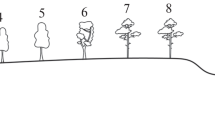Abstract
The patterns of changes in the species richness, abundance, species composition, and species structure of the testate amoebae community along six different types of water-land boundaries in the Medveditsa River (Don river Basin) were studied, namely, a new boundary, terrigenous and reogeneous edges, reogeneous and terrigenous hemiecotones, and the full ecotone. The testate amoebae communities are divided into terrestrial and aquatic variants for all types of boundaries. Hydrophilic species of the genera Arcella, Diffugia, Cyphoderia, and Pseudodifflugia dominate in the aquatic types of communities while pedobiont and eurybiont groups from the genera Centropyxis, Euglypha, Plagiopyxis, and Trinema are characteristic of the terrestrial communities. A decrease in the abundance and species richness of testate amoebae in the boundary zones was detected.
Similar content being viewed by others
References
Balik, V., Testate amoebae community (Protozoa, Rhizopoda) in a meadow—spruce forest mesoecotone, Biologia (Bratislava), 1996a, vol. 51, pp. 117–124.
Balik, V., Testate amoebae communities (Protozoa, Rhizopoda) in two moss-soil microecotones, Biologia (Bratislava), 1996b, vol. 51, pp. 125–133.
Camarero, J., Gutierrez, E., and Fortin, M.-J., Spatial patterns of plant richness across treeline ecotones in the Pyrenees reveal different locations for richness and tree cover boundaries, Global Ecol. Biogeogr., 2006, vol. 15, no. 2, pp. 182–191.
Yermokhin, M.V., Problems and prospects of studies on marginal structures of biocenoses of rivers and water bodies in river valleys, in Aktual’nye voprosy izucheniya mikro-, meiozoobentosa i fauny zaroslei presnovodnykh vodoemov: tematicheskie lektsii i materialy I Mezhdunar. shkoly-konf. (Current Problems in Studies on the Micro- and Meiozoobenthos and the Fauna of Vegetation Overgrowing Fresh Water Bodies: Thematic Lectures and Materials of I Int. Workshop-Conference), Nizhni Novgorod, 2007, pp. 101–129.
Fagan, W., Fortin, M.-J., and Soykan, C., Integrating edge detection and dynamic modeling in quantitative analyses of ecological boundaries, BioScience, 2003, vol. 53, no. 8, pp. 730–738.
Fortin, M.-J., Olson, R.J., Ferson, S., Iverson, L., Hunsaker, C., Edwards, G., Levine, D., Butera, K., and Klemas, V., Issues related to the detection of boundaries, Landsc. Ecol., 2000, vol. 15, pp. 453–466.
Hammer, Ø., Harper, D.A.T., and Ryan, P.D., PAST: palaeontological statistics software package for education and data analysis, Palaeontol. Electron., 2001, vol. 4, no. 1, pp. 1–9.
Kolasa, J. and Zalewski, M., Notes on ecotone attributes and functions, Hydrobiologia, 1995, vol. 303, pp. 1–7.
Korganova, G.A., Organization of soil communities of testate amoebae (Protozoa, Testacea), Zool. Zh., 1999, vol. 78, no. 12, pp. 1396–1406.
Kozlova, G.I., Gorbovskaya, A.A., and Tret’yakov, V.Yu., The lake floodplain ecotone and its interaction with the aquatic system, in Ekosistema ozera Il’men’ i ego poimy (The Ecosystem of Lake Il’men and Its Floodplain), St. Petersburg: S.-Peterb. Gos. Univ., 1997, pp. 97–150.
Mazei, Yu.A. and Embulaeva, E.A., Community structure of soil testate amoebae in the Ostrovtsovskaya forest-steppe (the Middle Volga region): effect of forest-steppe gradient, Usp. Sovrem. Biol., 2008, vol. 128, no. 5, pp. 532–540.
Mazei, Yu.A. and Embulaeva, E.A., Changes in communities of soil testate amoebae along the forest-steppe gradient in the Middle Volga region, Arid. Ekosist., 2009, vol. 15, no. 1 (37), pp. 13–23.
Mazei, Yu.A. and Tsyganov, A.N., Testate amoebae from freshwater ecosystems of the Sura River floodplain (Middle Volga region). 1. Fauna and morphological-ecological characteristics of species, Zool. Zh., 2006a, vol. 85, pp. 1267–1280.
Mazei, Yu.A. and Tsyganov, A.N., Testate amoebae from freshwater ecosystems of the Sura River floodplain (Middle Volga region). 2. Community structure, Zool. Zh., 2006b, vol. 85, no. 12, pp. 1395–1401.
McClain, M., Boyer, E., Dent, L., Gergel, S., Grimm, N., Groffman, P., Hart, S., Harvey, J., Johnston, C., Mayorga, E., McDowell, W., and Pinay, G., Biogeochemical hot spots and hot moments at the interface of terrestrial and aquatic ecosystems, Ecosystems, 2003, vol. 6, pp. 301–312.
Mirkin, B.M., Naumova, L.G., and Solomeshch, A.I., Sovremennaya nauka o rastitel’nosti (Modern Science of Vegetation), Moscow: Logos, 2002.
Naiman, R. and Decamps, H., The ecology of interfaces: riparian zones, Annu. Rev. Ecol. Syst., 1997, vol. 28, pp. 621–658.
Naiman, R., Decamps, H., and Pollock, M., The role of riparian corridors in maintaining regional biodiversity, Ecol. Appl., 1993, vol. 3, pp. 203–212.
Pinay, G., Decamps, H., Chauvet, E., and Fustec, E., Functions of ecotones in fluvial systems, in The Ecology and Management of Aquatic-Terrestrial Ecotones, Naiman, R. and Decamps, H., Eds., Paris: Parthenon, 1990, pp. 141–169.
Tabacchi, E., Planty-Tabacchi, A.-M., and Deamps, O., Continuity and discontinuity of the riparian vegetation along a fluvial corridor, Landsc. Ecol., 1990, vol. 5, pp. 9–20.
Wang, W. and Yin, Ch., The boundary filtration effect of reed-dominated ecotones under water level fluctuations, Wetl. Ecol. Manag., 2002, vol. 16, no. 1, pp. 65–76.
Ward, W. and Stanford, J., The serial discontinuity concept: extending the model to floodplain rivers, Regul. River. Res. Manag., 1995, vol. 10, nos. 2–4, pp. 159–168.
Ward, J., Tockner, K., Arscott, D., and Claret, C., Riverine landscape diversity, Freshw. Biol., 2002, vol. 47, no. 4, pp. 517–539.
Zaletaev, V.S., The world ecotone network: its function in the biosphere and role in global changes, in Ekotony v biosfere (Ecotones in the Biosphere), Moscow: RASKhN, 1997, pp. 77–89.
Author information
Authors and Affiliations
Corresponding author
Additional information
Original Russian Text © E.A. Malysheva, Yu.A. Mazei, M.V. Yermokhin, 2011, published in Povolzhskii Ekologicheskii Zhurnal, 2011, No. 4, pp. 455–468.
Rights and permissions
About this article
Cite this article
Malysheva, E.A., Mazei, Y.A. & Yermokhin, M.V. Testate amoebae community pattern in different types of boundary structures at the water-land contact zone. Biol Bull Russ Acad Sci 40, 823–831 (2013). https://doi.org/10.1134/S106235901310004X
Received:
Published:
Issue Date:
DOI: https://doi.org/10.1134/S106235901310004X



